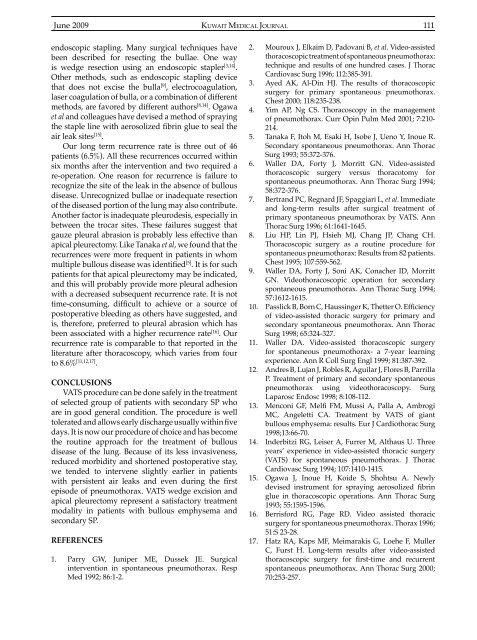June 09-41-2.indd - Kma.org.kw
June 09-41-2.indd - Kma.org.kw
June 09-41-2.indd - Kma.org.kw
You also want an ePaper? Increase the reach of your titles
YUMPU automatically turns print PDFs into web optimized ePapers that Google loves.
<strong>June</strong> 20<strong>09</strong>KUWAIT MEDICAL JOURNAL 111endoscopic stapling. Many surgical techniques havebeen described for resecting the bullae. One wayis wedge resection using an endoscopic stapler [3,14] .Other methods, such as endoscopic stapling devicethat does not excise the bulla [9] , electrocoagulation,laser coagulation of bulla, or a combination of differentmethods, are favored by different authors [8,14] . Ogawaet al and colleagues have devised a method of sprayingthe staple line with aerosolized fibrin glue to seal theair leak sites [15] .Our long term recurrence rate is three out of 46patients (6.5%). All these recurrences occurred withinsix months after the intervention and two required are-operation. One reason for recurrence is failure torecognize the site of the leak in the absence of bullousdisease. Unrecognized bullae or inadequate resectionof the diseased portion of the lung may also contribute.Another factor is inadequate pleurodesis, especially inbetween the trocar sites. These failures suggest thatgauze pleural abrasion is probably less effective thanapical pleurectomy. Like Tanaka et al, we found that therecurrences were more frequent in patients in whommultiple bullous disease was identified [5] . It is for suchpatients for that apical pleurectomy may be indicated,and this will probably provide more pleural adhesionwith a decreased subsequent recurrence rate. It is nottime-consuming, difficult to achieve or a source ofpostoperative bleeding as others have suggested, andis, therefore, preferred to pleural abrasion which hasbeen associated with a higher recurrence rate [16] . Ourrecurrence rate is comparable to that reported in theliterature after thoracoscopy, which varies from fourto 8.6% [11,12,17] .CONCLUSIONSVATS procedure can be done safely in the treatmentof selected group of patients with secondary SP whoare in good general condition. The procedure is welltolerated and allows early discharge usually within fivedays. It is now our procedure of choice and has becomethe routine approach for the treatment of bullousdisease of the lung. Because of its less invasiveness,reduced morbidity and shortened postoperative stay,we tended to intervene slightly earlier in patientswith persistent air leaks and even during the firstepisode of pneumothorax. VATS wedge excision andapical pleurectomy represent a satisfactory treatmentmodality in patients with bullous emphysema andsecondary SP.REFERENCES1. Parry GW, Juniper ME, Dussek JE. Surgicalintervention in spontaneous pneumothorax. RespMed 1992; 86:1-2.2. Mouroux J, Elkaim D, Padovani B, et al. Video-assistedthoracoscopic treatment of spontaneous pneumothorax:technique and results of one hundred cases. J ThoracCardiovasc Surg 1996; 112:385-391.3. Ayed AK, Al-Din HJ. The results of thoracoscopicsurgery for primary spontaneous pneumothorax.Chest 2000; 118:235-238.4. Yim AP, Ng CS. Thoracoscopy in the managementof pneumothorax. Curr Opin Pulm Med 2001; 7:210-214.5. Tanaka F, Itoh M, Esaki H, Isobe J, Ueno Y, Inoue R.Secondary spontaneous pneumothorax. Ann ThoracSurg 1993; 55:372-376.6. Waller DA, Forty J, Morritt GN. Video-assistedthoracoscopic surgery versus thoracotomy forspontaneous pneumothorax. Ann Thorac Surg 1994;58:372-376.7. Bertrand PC, Regnard JF, Spaggiari L, et al. Immediateand long-term results after surgical treatment ofprimary spontaneous pneumothorax by VATS. AnnThorac Surg 1996; 61:16<strong>41</strong>-1645.8. Liu HP, Lin PJ, Hsieh MJ, Chang JP, Chang CH.Thoracoscopic surgery as a routine procedure forspontaneous pneumothorax: Results from 82 patients.Chest 1995; 107:559-562.9. Waller DA, Forty J, Soni AK, Conacher ID, MorrittGN. Videothoracoscopic operation for secondaryspontaneous pneumothorax. Ann Thorac Surg 1994;57:1612-1615.10. Passlick B, Born C, Haussinger K, Thetter O. Efficiencyof video-assisted thoracic surgery for primary andsecondary spontaneous pneumothorax. Ann ThoracSurg 1998; 65:324-327.11. Waller DA. Video-assisted thoracoscopic surgeryfor spontaneous pneumothorax- a 7-year learningexperience. Ann R Coll Surg Engl 1999; 81:387-392.12. Andres B, Lujan J, Robles R, Aguilar J, Flores B, ParrillaP. Treatment of primary and secondary spontaneouspneumothorax using videothoracoscopy. SurgLaparosc Endosc 1998; 8:108-112.13. Menconi GF, Melfi FM, Mussi A, Palla A, AmbrogiMC, Angeletti CA. Treatment by VATS of giantbullous emphysema: results. Eur J Cardiothorac Surg1998;13:66-70.14. Inderbitzi RG, Leiser A, Furrer M, Althaus U. Threeyears’ experience in video-assisted thoracic surgery(VATS) for spontaneous pneumothorax. J ThoracCardiovasc Surg 1994; 107:1<strong>41</strong>0-1<strong>41</strong>5.15. Ogawa J, Inoue H, Koide S, Shohtsu A. Newlydevised instrument for spraying aerosolized fibringlue in thoracoscopic operations. Ann Thorac Surg1993; 55:1595-1596.16. Berrisford RG, Page RD. Video assisted thoracicsurgery for spontaneous pneumothorax. Thorax 1996;51:S 23-28.17. Hatz RA, Kaps MF, Meimarakis G, Loehe F, MullerC, Furst H. Long-term results after video-assistedthoracoscopic surgery for first-time and recurrentspontaneous pneumothorax. Ann Thorac Surg 2000;70:253-257.
















